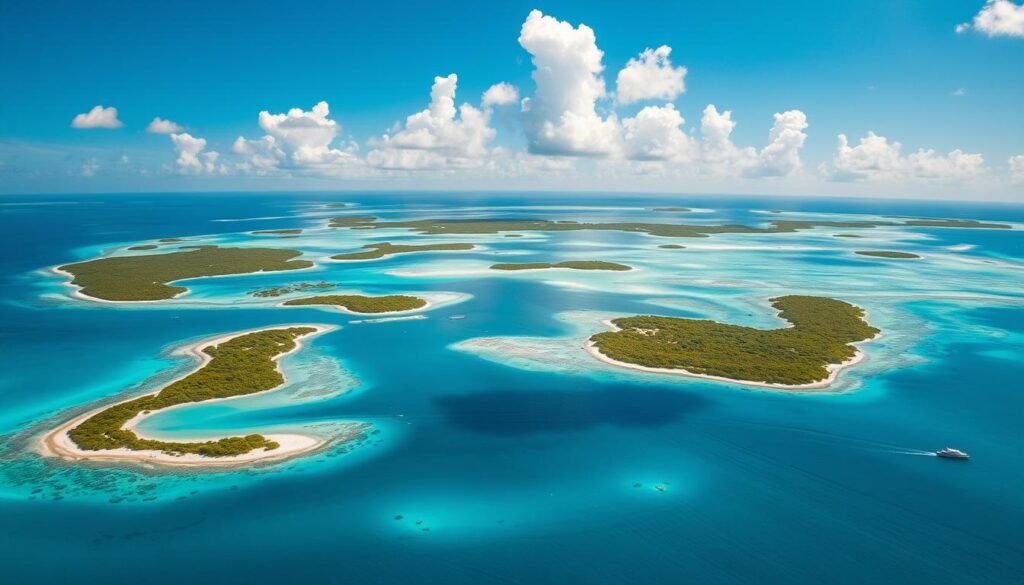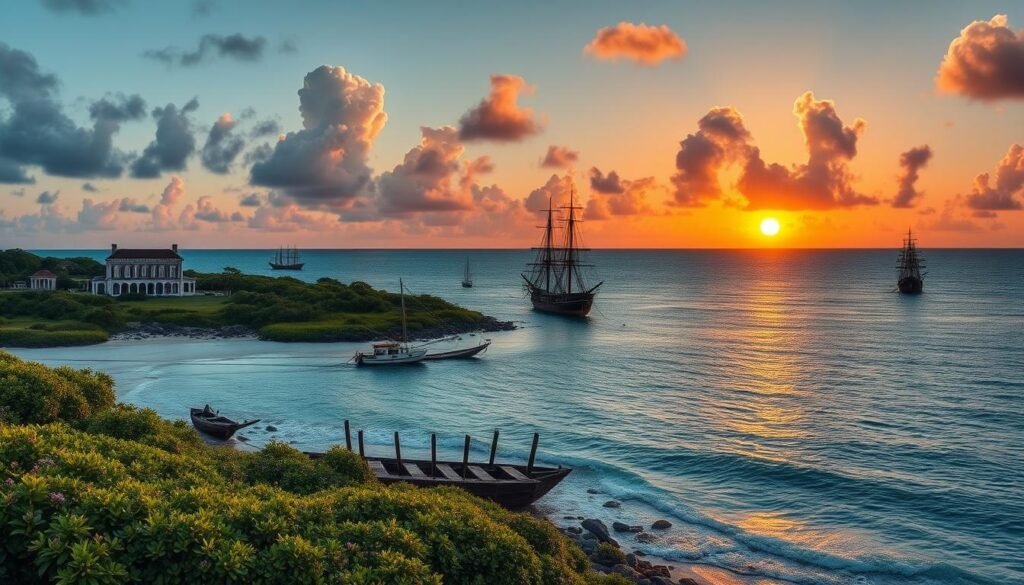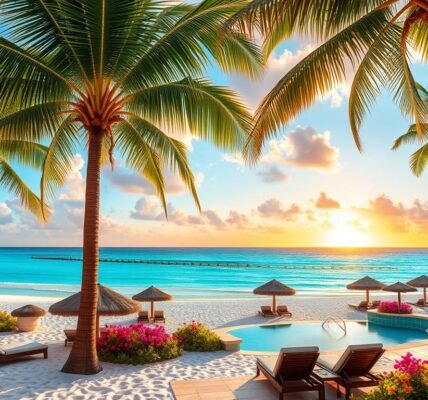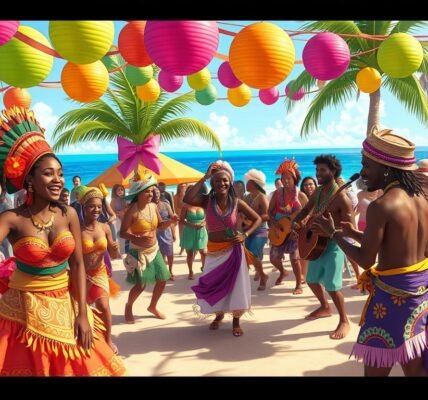Ever wondered how a group of islands could shape a nation’s culture and economy? The Abaco Islands in the Bahamas have a story that’s full of twists and turns. From ancient cultures to colonial times and today’s struggles, their history is rich and varied.
The Abaco Islands sit in the Atlantic Ocean, covering 2,009 km². They are home to 16,587 people as of 20221. Their unique geography and history make them key to the Bahamas’ past. The islands were once home to the Lucayan people, with a population of about 40,000 before Europeans arrived2. Later, British Loyalists fleeing the American War of Independence settled here in 1783, adding to the islands’ complex history1.
Today, the Abaco Islands face the challenge of keeping their heritage alive while dealing with modern problems. These include finding economic stability and coping with natural disasters like Hurricane Dorian. Join us as we explore the Abaco Islands’ history and see why they are a symbol of resilience and importance.
Key Takeaways
- The Abaco Islands cover 2,009 km², housing a population of over 16,000 people as of 2022.
- The islands were originally inhabited by the Lucayan people before European contact drastically diminished their numbers.
- British Loyalists began settling in Abaco around 1783, contributing to the cultural and economic landscape.
- Notable shipbuilding and wrecking industries emerged that shaped the economic history of the islands.
- Hurricanes like Dorian have significantly impacted Abaco’s environment and communities throughout history.
- Abaco Islands play a crucial role in understanding the broader story of the Bahamas’ maritime economy and heritage.
- Modern challenges include preserving historical sites while revitalizing local communities and economies.
Introduction to the Abaco Islands
The Abaco Islands are in the northern Bahamas, with 120 islands including Great and Little Abaco. This beautiful area has many uninhabited islets, cays, and beaches. It covers 775 square miles34. Known for its Abaco Islands heritage, it draws visitors with its lively Abaco Islands culture and many Abaco Islands attractions.
Activities like sailing, fishing, and diving are big here, making it a key spot for water sports3. You can find marinas for luxury yachts, offering deep-sea fishing and reef or shipwreck exploration3. Hope Town on Elbow Cay offers special sailing tours, letting you enjoy the scenery3.
On the island, you’ll find places like Treasure Cay with three and a half miles of beach for swimming with turtles3. Green Turtle Cay is easy to get around on foot or by golf cart. It has a barrier reef great for snorkeling and diving3. This fishing village has New England-style houses and amazing views, showing its strong maritime history4.
The Geography of the Abaco Islands
The Abaco Islands are a beautiful archipelago in the Bahamas. They are about 193 miles east of Miami, Florida. This makes them a treasure in the Caribbean. The islands are 120 miles long and have stunning marine ecosystems.
Location and Major Islands
Great Abaco and Little Abaco are the main islands. There are also barrier cays like Walker’s Cay and Grand Cay. These all add to the Abaco Islands geography. The area has about 31 government districts, each with its own charm and attractions for tourists and locals5.
Unique Environmental Features
The Abaco Islands have limestone topography and beautiful tidal mangrove swamps. They have more blue holes than anywhere else, offering amazing diving spots. The Fowl Cay Government Preserve lets divers explore depths from 30 to 98 feet6.
The waters are home to the third-largest barrier reef globally. This supports a wide range of marine species . The Sea of Abaco is famous for its clear waters and diverse marine life.

Visiting the sandy beaches, you’ll find Sandy Cay in the Pelican Cay National Land and Sea Park. It has the largest Elkhorn coral stand globally. This vibrant ecosystem draws visitors for swimming, snorkeling, and scuba diving6. It lets you connect with the lively marine life in these waters.
Early Inhabitants of the Abaco Islands
The Abaco Islands have a rich history. The Lucayan people were among the first Abaco early inhabitants. They came to the islands around 700 AD, fleeing from the Carib Indians.
They built a culture based on farming, fishing, and crafting. They used shells and wood for their work.
The Lucayan People and Their Culture
The Lucayans thrived, with over 20,000 by the 1520s. They lived off the land and sea, using what nature provided. But, the arrival of Europeans in the late 15th century changed everything.
The Impact of European Contact
In 1492, Christopher Columbus saw the islands. This marked a sad time for the Lucayans. The Spanish took many as slaves, causing their numbers to drop sharply by the 1520s.
This period still affects the islands today. You can see remnants of their settlements. For more on this, read about it here7.
The Abaco Islands During the Pre-Columbian Era
The Abaco Islands’ history is deeply influenced by the Lucayan people from the Abaco Islands pre-Columbian era. This time period shaped their way of life and their cultural impact, which is still felt today.
Life of the Lucayans in Abaco
The Lucayans lived well in the Abaco Islands. They focused on farming, fishing, and trading. They made the most of the islands’ resources, which gave them food and items to trade.
Their culture was all about community and respecting nature. This is seen in their traditions and how they lived.
Legacy of the Lucayan Population
Even after colonization, the legacy of Lucayans is still seen today. They left behind pottery and tools made from coral and conch shells. These show their skill and daily life.
These artifacts are key to understanding their history in the Bahamas.

The story of the Lucayans in the Abaco Islands is more than just history. It helps shape the Bahamas’ cultural identity89.
Colonial History of the Abaco Islands
The Abaco Islands have a rich colonial history. It was shaped by the arrival of British Loyalists in the late 18th century. These loyalists came after the American Revolutionary War, seeking refuge from persecution. They established thriving communities on the islands.
British Loyalists and Their Settlement
Between 1783 and 1788, thousands of British Loyalists settled in Abaco. They founded towns like Carleton and Marsh Harbour. This settlement changed the islands’ demographics, as the loyalists tried to rebuild their lives.
Family names like Bethel, Sawyer, and Thompson show their lasting impact. Despite challenges, the loyalists tried to grow crops like cotton and coffee. But the harsh environment made it tough. Their determination created a unique cultural mix that shapes the Abaco Islands today.
Economic Activities in the Colonial Era
In the colonial era, Abaco’s economy was varied. It focused on agriculture and maritime trades. Shipbuilding and salvaging shipwrecks were big successes, thanks to the islands’ strategic location.
Shipbuilding became a key industry, creating jobs and community spirit. Today, the legacy of these industries still shapes the Abaco Islands’ economy.
Historical Events That Shaped Abaco
The Abaco Islands have a rich history. The Nassau Slave Revolt in the 1830s was a key moment. It showed the fight for freedom and drew attention to the Nassau Slave Revolt Abaco.
The Nassau Slave Revolt Connections
The Nassau Slave Revolt happened in the early 19th century. It was a fight for freedom and justice. This event shows how social justice and human rights evolved in the Bahamas.
Impact of the American Revolution
The American Revolution impact in Abaco was big. Many Loyalists moved to the islands after the war. This changed the islands’ culture and economy.

The Nassau Slave Revolt and the American Revolution shaped Abaco. They created a unique history that still affects the region today. For more on Abaco’s history, check out this link about its cultural and historical significance1011.
Historical Significance of Abaco Islands
The Abaco Islands have played a key role in history, especially in maritime trade and wrecking. They sit on major shipping paths, making them crucial for trade and sea activities. The area’s many shipwrecks helped a wrecking industry grow, where locals salvaged goods from stranded ships.
This unique setup boosted the local economy, showing the islands’ people’s ability to adapt and thrive. It made the Abaco Islands a vital part of maritime history.
Role in Maritime Trade and Wrecking
The Abaco Islands’ location near the Great Guana Cay Barrier Reef has made navigation hard for centuries. This led to many shipwrecks, giving locals a chance to salvage goods. These stories show how maritime trade shaped the lives of Abaco’s people.
The bravery and resourcefulness of those who salvaged goods are part of the islands’ culture. Their stories highlight the community’s spirit and resilience.
Cultural Contributions to Bahamian Heritage
The Abaco Islands have greatly influenced Bahamian culture. The mix of Lucayan heritage and British Loyalists has enriched local traditions. This blend is seen in the islands’ music, dance, and crafts.
Events celebrating these traditions bring people together, showing the community’s pride in their history. These celebrations also draw visitors who want to see the rich culture of the Abaco Islands.
To learn more about the Abaco Islands’ history, check out this detailed exploration. It dives into their impact on maritime trade and cultural growth12.
Abaco Islands Historical Landmarks
The Abaco Islands are filled with historical landmarks that show their rich past. Each place tells a story of how this beautiful place came to be. You can explore architectural wonders or learn about the sea’s role in their history. This makes visiting Abaco’s historical sites a must.
Key Historic Sites to Visit
The Hope Town Lighthouse is a standout. Built in 1835, it was once opposed by locals who feared it would harm their shipwreck business. Today, it’s a key landmark for sailors and offers stunning views13. Don’t miss Elbow Reef Lighthouse, built in 1862. It’s still run manually and shows the area’s long history14.
Significant Structures and Their Stories
New Plymouth on Green Turtle Cay is a key historical site. It’s where colonial settlements began and the famous Goombay Smash cocktail was born. The area’s culture is seen in its buildings and traditions14. Man-O-War Cay is famous for its boat-building skills, passed down through generations. It’s a key place for preserving boat-making traditions13
Treasure Cay Beach is a must-see. It’s one of the world’s top beaches, with its white sand and clear waters. Exploring these sites will help you understand the Abacos’ culture and history13.
Impact of Hurricanes on the Abaco Islands
The Abaco Islands have long faced the threat of hurricanes. Hurricane Dorian was a major event in this struggle. It showed how vulnerable the islands are and the damage they’ve suffered from storms.
Hurricane Dorian and Its Aftermath
Hurricane Dorian hit the Abaco Islands on September 1, 2019. It was a Category 5 hurricane with winds up to 185 miles per hour. This made it one of the strongest Atlantic hurricanes ever recorded15.
The damage was huge, with over 74 deaths and 282 missing people16. The economic loss was $3.4 billion, with over $1 billion in insured damages16.
About 70,000 people lost their homes, and 13,000 homes were destroyed or badly damaged in the Bahamas16. Marsh Harbour in the Abaco Islands saw 90% of its buildings damaged16.
Historical Context of Devastation in Abaco
Hurricanes have always been a big problem in the Abaco Islands. Over the years, storms have changed the culture and buildings of the islands showing the need for ongoing research on hurricanes Abaco. Hurricane Dorian’s attack is a clear reminder of this vulnerability15.
The people of the Abaco Islands have always tried to rebuild and recover. Dorian’s destruction is a challenge but also a source of hope. It shows the community’s strength and resilience in the face of historical devastation.
Abaco Islands Cultural Legacy
The Abaco Islands have a rich cultural history. This history is shaped by many influences over time. The community works hard to keep traditions alive, like music, food, and festivals.
These traditions show the mix of Lucayan and Loyalist histories. They also show the community’s dedication to preserving their culture. This makes the cultural scene even more vibrant.
Preservation of Traditions and Practices
Community programs are key in keeping traditions alive in Abaco. Events like Junkanoo festivals and art shows bring people together. They celebrate their heritage and teach the next generation about their roots.
This keeps the past alive and teaches the importance of heritage. It shows how each person plays a part in Bahamian culture.
Modern Influence on Bahamian Culture
The Abaco Islands have a big impact on Bahamian culture. Tourism brings visitors who want to experience the islands’ unique traditions. They see the cultural legacy in food, music, and crafts.
This enriches the national identity and builds appreciation for the islands. The Abaco culinary scene is a big part of this. It uses local ingredients and traditional recipes, giving visitors a real taste of the islands’ history.

Historical Tourism in the Abaco Islands
The Abaco Islands are rich in history, making them perfect for history lovers. You can explore Loyalist ruins and museums. These places tell stories of the past. Tours in Abaco let you uncover the islands’ heritage.
Attractions for History Buffs
History buffs will love the Abaco Islands. You can see Loyalist settlements from the late 18th century. These sites show how early settlers lived and thrived.
- Hope Town Lighthouse – Built in 1863, it’s a key landmark for sailors.
- Museums – They have artifacts from the colonial era and insights into the Lucayan people.
- Loyalist Ruins – See the remains of settlements after the American Revolution. Guides share their history.
Historical Tours Available
Guided tours in Abaco make history come alive. Guides share stories and point out landmarks. These tours highlight key events and the people’s stories, making your visit unforgettable.
| Tour Options | Description | Duration |
|---|---|---|
| Loyalist Heritage Tour | Explore Loyalist ruins and learn about their impact on Abaco’s history. | Half-day |
| Hope Town Walking Tour | A guided walk through Hope Town, focusing on its history and notable structures. | 2 hours |
| Abaco Historical Museum Tour | Visit the museum to see exhibits on the islands’ past. | 1 hour |
With many Abaco historical attractions and experiences, planning a trip here is exciting. Dive into this journey and discover the islands’ stories171819.
Archaeological Sites in the Abaco Islands
The Abaco Islands are home to many archaeological sites. These sites help us understand the islands’ history. They show us how early people lived and how the area changed over time.
Importance of Archaeology in Understanding Abaco’s Past
Studies of these sites have shed light on the Lucayan people. We now know more about their culture and how they lived with nature. This knowledge helps us see how they adapted to their environment.
Notable Excavations and Findings
One of the most exciting finds in Abaco are the blue holes. Places like Sawmill Sink and Dan’s Cave have fossils over 10,000 years old20. These underwater caves tell us about ancient animals, including 50 bird species from the last ice age20.
Excavations have also found evidence of 22 species that vanished after humans arrived20 and21. These discoveries keep researchers and historians interested. They help us understand the Abaco Islands’ past and how they’ve changed.

Contemporary Historical Preservation Efforts
Keeping the Abaco Islands’ rich history alive is a big job. Many groups and community projects work hard to save historic sites. They also teach people about the islands’ cultural past. These organizations in Abaco are key to keeping the islands’ stories and traditions alive.
Organizations Involved in Preservation
Local groups in Abaco focus on saving traditional buildings and crafts. They work hard to restore these important parts of the islands’ history. The community’s efforts are vital in keeping the islands’ identity and heritage strong.
After Hurricane Dorian in 2019, Abaco residents showed great strength. They quickly started rebuilding historic sites and buildings.
Community Engagement in History Conservation
Getting the community involved in saving history is crucial. People in Abaco join workshops on local crafts and building methods. They learn about the importance of their landmarks.
Working together, the community raises awareness of the islands’ heritage. This ensures the history of Abaco is cherished by both locals and visitors. These efforts are supported by ongoing cultural programs.
Future Perspectives on Abaco Islands’ Heritage
The future of Abaco’s heritage is tied to solving big problems and grabbing new chances. Climate change and natural disasters threaten the islands’ cultural sites. It’s vital to protect the rich cultural mix of Bahamians as the islands evolve22.
Challenges Facing Historical Sites
Abaco’s historical sites face big challenges. Environmental changes risk their safety and how people can visit them. With 14,000 people counting on these sites, it’s key to plan for their future23.
Opportunities for Cultural Revival
Yet, there’s a chance for a cultural rebirth in Abaco. Local efforts to highlight the islands’ history can boost pride and involvement. By promoting historical tourism, we can draw in curious visitors and help the local economy22. This balance between saving history and growing the economy is crucial for Abaco’s heritage to thrive.

Conclusion
The Abaco Islands are key in Bahamian history. They show the unique culture and strong past of local communities. Exploring Abaco’s history, you learn about its early people and the changes brought by colonial times.
This history is rich and complex. It shows how different groups have shaped these islands. From the Lucayan people to modern times, each era has left its mark.
Recently, mission trips have brought attention to Abaco’s challenges. A group of eighteen people spent a week helping local kids. They faced tough home situations and limited resources24.
These efforts show the importance of community and family. They bring hope and learning, essential for the future.
Thinking about the Abaco Islands’ history helps us appreciate their culture and past. By helping preserve this history, we support Abaco’s legacy and the Bahamas’ identity25.
FAQ
What is the historical significance of the Abaco Islands?
What cultural traditions can I explore in the Abaco Islands?
What are some key historical landmarks in the Abaco Islands?
How did the American Revolution impact the Abaco Islands?
What are some historical tourism activities available in the Abaco Islands?
How have hurricanes affected the historical sites in the Abaco Islands?
Why is archaeological research important in the Abaco Islands?
What efforts exist to preserve the Abaco Islands’ history?
What challenges does the cultural heritage of the Abaco Islands face today?
Source Links
- https://en.wikipedia.org/wiki/Abaco_Islands
- https://abacosun.com/a-brief-history-of-abaco/
- https://www.bon-voyage.co.uk/destinations/the_abaco_islands
- https://hsjchronicle.com/the-abaco-islands/
- https://worldpopulationreview.com/regions/abaco-island
- https://www.madurodive.com/2014/11/17/abaco-the-treasure-of-the-bahamas-out-islands/
- https://islandmapstore.com/2019/05/the-history-of-abaco-bahamas/
- https://reason.com/1974/10/01/abaco/
- https://shannonleighobrien.wordpress.com/2021/06/05/two-months-on-great-abaco-a-guide-to-marsh-harbour-and-beyond/
- https://www.notesfromtheroad.com/westindies/abaco-islands.html
- https://rollingharbour.com/2012/04/08/abaco-hole-in-the-wall-bahamas-a-short-history-in-maps/
- https://www.burgessyachts.com/en/editorial/news/why-the-abacos-islands-are-worth-visiting-during-y
- https://www.myoutislands.com/bahamas-islands/abaco/landmarks-attractions
- https://www.bahamas.com/islands/abacos
- https://www.projecthope.org/news-stories/responses/hurricane-dorian-what-you-need-to-know/
- https://en.wikipedia.org/wiki/Effects_of_Hurricane_Dorian_in_the_Bahamas
- https://bnt.bs/explore/abaco/abaco-national-park/
- https://www.tourismtoday.com/sites/default/files/docs/stats/AbacoBrochure2011.pdf
- https://www.hopetownguide.com/history
- https://www.floridamuseum.ufl.edu/science/protecting-a-sunken-ancient-world/
- https://www.abacopalms.com/abaco-info/explore-the-abacos/blue-holes-of-abaco/
- https://journals.sfu.ca/cob/index.php/files/article/view/280/pdf_47
- https://sports.yahoo.com/news/discover-hottest-hidden-gem-bahamas-123000910.html
- https://www.teenink.com/nonfiction/travel_culture/article/947920/Abaco-Islands-Bahamas
- https://rollingharbour.com/2013/01/21/abaco-history-ships-maps-hole-in-the-wall/





